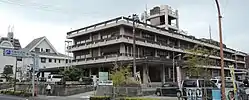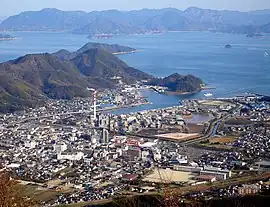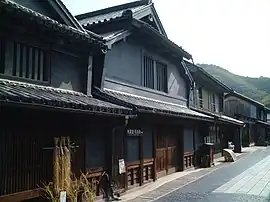Takehara, Hiroshima
Takehara (竹原市, Takehara-shi) is a city located in Hiroshima Prefecture, Japan. As of 30 April 2023, the city had an estimated population of 23,350 in 12034 households and a population density of 200 persons per km².[1] The total area of the city is 118.23 square kilometres (45.65 sq mi).
Takehara
竹原市 | |
|---|---|
 Takehara city hall | |
 Flag  Seal | |
Location of Takehara in Hiroshima Prefecture | |
 | |
 Takehara Location in Japan | |
| Coordinates: 34°20′30″N 132°54′25″E | |
| Country | |
| Region | Chūgoku (San'yō) |
| Prefecture | Hiroshima |
| Area | |
| • Total | 118.23 km2 (45.65 sq mi) |
| Population (April 30, 2023) | |
| • Total | 23,350 |
| • Density | 200/km2 (510/sq mi) |
| Time zone | UTC+09:00 (JST) |
| City hall address | 5-1-35 Takehara Chuo, Takehara-shi, Hiroshima-ken 725-8666 |
| Climate | Cfa |
| Website | www |
| Symbols | |
| Flower | Ume |
| Tree | Bamboo |



Geography
Mihara is located in south-central Hiroshima Prefecture. It faces the Seto Inland Sea to the south. The urban area is broadly divided into a fan-shaped public office/commercial district centered on Takehara Station, a harbor/industrial district centered around the port, and a townscape preservation district that includes temples and other cultural properties. Ōkunoshima, the island where a poison gas plant of the Imperial Japanese Army was located, belongs to Takehara.
Climate
Takehara has a humid subtropical climate (Köppen climate classification Cfa) characterized by cool to mild winters and hot, humid summers. The average annual temperature in Takehara is 15.4 °C (59.7 °F). The average annual rainfall is 1,212.3 mm (47.73 in) with July as the wettest month. The temperatures are highest on average in August, at around 26.5 °C (79.7 °F), and lowest in January, at around 5.7 °C (42.3 °F).[2] The highest temperature ever recorded in Takehara was 34.8 °C (94.6 °F) on 6 August 2017; the coldest temperature ever recorded was −6.6 °C (20.1 °F) on 26 February 1981.[3]
| Climate data for Takehara (1991−2020 normals, extremes 1979−present) | |||||||||||||
|---|---|---|---|---|---|---|---|---|---|---|---|---|---|
| Month | Jan | Feb | Mar | Apr | May | Jun | Jul | Aug | Sep | Oct | Nov | Dec | Year |
| Record high °C (°F) | 15.9 (60.6) |
19.5 (67.1) |
22.4 (72.3) |
25.2 (77.4) |
26.7 (80.1) |
30.9 (87.6) |
34.8 (94.6) |
34.8 (94.6) |
34.0 (93.2) |
30.1 (86.2) |
23.7 (74.7) |
20.3 (68.5) |
34.8 (94.6) |
| Average high °C (°F) | 9.4 (48.9) |
9.7 (49.5) |
12.5 (54.5) |
16.9 (62.4) |
21.2 (70.2) |
24.1 (75.4) |
27.7 (81.9) |
30.0 (86.0) |
27.5 (81.5) |
22.5 (72.5) |
17.1 (62.8) |
11.9 (53.4) |
19.2 (66.6) |
| Daily mean °C (°F) | 5.7 (42.3) |
5.8 (42.4) |
8.6 (47.5) |
13.0 (55.4) |
17.3 (63.1) |
20.8 (69.4) |
24.5 (76.1) |
26.5 (79.7) |
23.7 (74.7) |
18.4 (65.1) |
12.9 (55.2) |
8.0 (46.4) |
15.4 (59.8) |
| Average low °C (°F) | 2.0 (35.6) |
1.9 (35.4) |
4.5 (40.1) |
9.1 (48.4) |
13.8 (56.8) |
18.2 (64.8) |
22.1 (71.8) |
23.9 (75.0) |
20.5 (68.9) |
14.7 (58.5) |
9.0 (48.2) |
4.2 (39.6) |
12.0 (53.6) |
| Record low °C (°F) | −4.7 (23.5) |
−6.6 (20.1) |
−3.1 (26.4) |
−0.1 (31.8) |
5.8 (42.4) |
11.7 (53.1) |
16.1 (61.0) |
17.4 (63.3) |
10.3 (50.5) |
4.8 (40.6) |
0.3 (32.5) |
−3.2 (26.2) |
−6.6 (20.1) |
| Average precipitation mm (inches) | 38.1 (1.50) |
48.5 (1.91) |
88.6 (3.49) |
95.6 (3.76) |
121.1 (4.77) |
193.2 (7.61) |
213.7 (8.41) |
98.1 (3.86) |
121.8 (4.80) |
86.4 (3.40) |
59.9 (2.36) |
45.3 (1.78) |
1,212.3 (47.73) |
| Average precipitation days (≥ 1.0 mm) | 5.0 | 6.8 | 9.1 | 9.2 | 8.9 | 10.8 | 9.8 | 7.0 | 8.3 | 6.6 | 6.0 | 5.5 | 93 |
| Mean monthly sunshine hours | 156.5 | 153.6 | 180.2 | 199.9 | 219.2 | 166.6 | 205.1 | 238.5 | 172.5 | 183.6 | 163.2 | 154.7 | 2,190.8 |
| Source: Japan Meteorological Agency[2][3] | |||||||||||||
Demographics
Per Japanese census data, the population of Takehara in 2020 is 23,993 people.[4] Takehara has been conducting censuses since 1960.
| Year | Pop. | ±% |
|---|---|---|
| 1960 | 36,424 | — |
| 1965 | 35,018 | −3.9% |
| 1970 | 35,017 | −0.0% |
| 1975 | 36,273 | +3.6% |
| 1980 | 36,895 | +1.7% |
| 1985 | 36,286 | −1.7% |
| 1990 | 34,771 | −4.2% |
| 1995 | 33,451 | −3.8% |
| 2000 | 31,935 | −4.5% |
| 2005 | 30,657 | −4.0% |
| 2010 | 28,655 | −6.5% |
| 2015 | 26,426 | −7.8% |
| 2020 | 23,993 | −9.2% |
| Takehara population statistics[4] | ||
History
The Takehara area is part of ancient Aki Province and has been settled since prehistoric times. During the Heian period, it was the location of a shōen landed estate controlled by Shimogamo Shrine in Kyoto Known as a port town since the Muromachi period, it prospered as a center of the salt industry in the latter half of the Edo period under the control of Hiroshima Domain. After the Meiji restoration, the area become part of Kamo District, Hiroshima. On April 1, 1889 the village of Shimoichi was formed with the establishment of the modern municipalities system. On April 17, 1889 Shimoichi was elevated to town status to become the town of Takehara. Takehara was elevated to city status on November 3, 1958. Takehara's Special Historical District of old warehouses was selected as one of Japan's "100 Most Scenic Towns".
Government
Takahara has a mayor-council form of government with a directly elected mayor and a unicameral city council of 14 members. Mihara, collectively with the town of Ōsakikamijima, contributes one member to the Hiroshima Prefectural Assembly. In terms of national politics, the city is part of the Hiroshima 5th district of the lower house of the Diet of Japan.
Economy
Takehara's economy is based on agriculture, commercial fishing and food processing. The city is also promoting its historical district as a tourist destination as the "Little Kyoto of Aki".
Education
Takehara has eight public elementary schools, and three public junior high schools operated by the city government, and two public high schools operated by the Hiroshima Prefectural Board of Education. Hiroshima University's Fisheries Experiment Station is located in Takehara.
Transportation
Sister city relations
Local attractions
Museums
Mountains and Islands
- Mount Asahi (Otake) [10] (in Japanese)
- Mount Kurotaki [11]
- Ōkunoshima Island [12]
"Little Kyoto of Aki Province"
Hot spring and Sakura (Cherry Blossom Tree) Park
Festivals and Events
- Miyatoko Children's Festival at Tadanoumi [21] (April) (in Japanese)
- Nika Village Renge (Lotus) Festival [22] (April)
- Takehara Take (Bamboo) Festival in the Conserved Townscape [23] (May)
- Tadanoumi Gion (Purification Ritual) Festival [24] (July) (in Japanese)
- Takehara Tanabata Festival [25] (July) (in Japanese)
- Tadanoumi Tenjin Yoichi Summer Festival [26] (July)
- Takehara Sumiyoshi Shrine Sea Festival [27] (August) (in Japanese)
- Takehara Summer Festival Fireworks [28] (August) (in Japanese)
- Fukuda Shishimai Lion Dance[29] (October) (in Japanese)
- Bamboo Candle Light Festival Shokei no Michi [30] (October) (in Japanese)
- Takehara Ekiden [31] (October)
- Rabbit Cross Country Short Running Race on Ōkunoshima Island [32] (November)
- Shinmeisai Fire Festival at Futamado,Tadanoumi [33] (February) (in Japanese)
Notable people from Takehara
- Shōgo Hamada, singer-songwriter
- Hayato Ikeda, Prime Minister from 1960 - 1964
- Naganori Ito, Chief development engineer of Nissan Skyline[34]
- Masataka Taketsuru, founder of Japan's whisky industry
References
- "Takehara city official statistics" (in Japanese). Japan.
- 気象庁 / 平年値(年・月ごとの値). JMA. Retrieved May 13, 2022.
- 観測史上1~10位の値(年間を通じての値). JMA. Retrieved May 13, 2022.
- Takehara population statistics
- Takehara Museum
- Kaguyahime Bamboo Princess Museum
- Masayuki Imai (Ceramic Artist) Museum (in Japanese)
- History of Takehara Museum
- Ozasaya Sake Museum
- Mount Asahi (Otake) (in Japanese)
- Mount Kurotaki
- Ōkunoshima Island
- Important Preservation Districts for Groups of Historic Buildings in Japan
- Okakae Jizo Statue
- Chosei-ji Temple (in Japanese)
- Saiho-ji (Takehara) Temple
- Shoren-ji Temple
- Kodo Ebisu-do Shrine (in Japanese)
- Yusaka Onsen-kyo (in Japanese)
- Comprehensive Park Bamboo Joy Highland (in Japanese)
- Miyatoko Children's Festival at Tadanoumi (in Japanese)
- Nika Village Renge (Lotus) Festival
- Takehara Take (Bamboo) Festival in the Conserved Townscape
- Tadanoumi Gion (Purification Ritual) Festival (in Japanese)
- Takehara Tanabata Festival (in Japanese)
- Tadanoumi Tenjin Summer Festival
- Takehara Sumiyoshi Shrine Sea Festival (in Japanese)
- Takehara Summer Festival Fireworks (in Japanese)
- Fukusa Shishimai Lion Dance (in Japanese)
- Bamboo Candle Light Festival Shokei no Michi (in Japanese)
- Takehara Ekiden
- Rabbit Cross Country Short Running Race on Ōkunoshima Island
- Shinmeisai Fire Festival at Futamado,Tadanoumi (in Japanese)
- Naganori Ito - Designer's emotion over the Skyline Nissan Motor Official Website (Japanese) July 22, 2008
- Takehara: Home of Tamayura
- "For first time, NHK seeks Caucasian actress to star in morning drama". 19 November 2013.
- "The Japan News".
External links
- Takehara City official website (in Japanese)